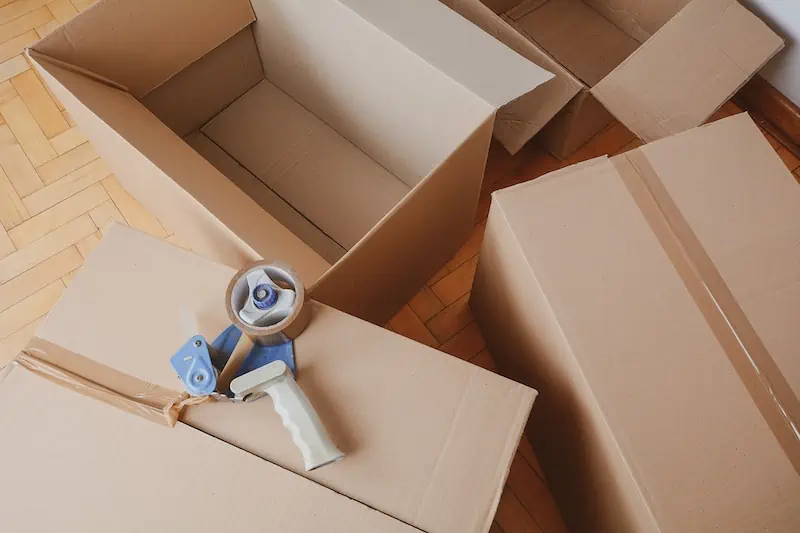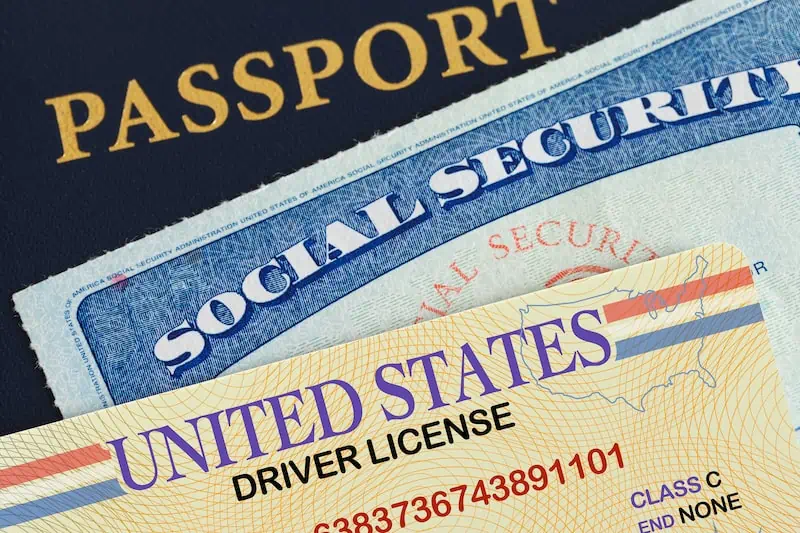Deciding how to move to another state is a big undertaking, especially compared to local moves. In addition to finding a new home, packing, and transporting your stuff, there are a bunch of administrative details to take care of.
Because your new state has its own systems and laws, you’ll need to change your driver’s license, insurance policies, memberships, and more. Then, there’s the process of finding new schools and healthcare providers and transferring your records.
With all there is to do, it’s easy for things to fall through the cracks, but there’s no need to worry. We’ve created a convenient checklist to help you plan a structured, low-stress move and avoid the common pitfalls people tend to forget about.
What to Consider Before Moving to Another State
Moving to a new state can be an exciting adventure. But before you commit, you should figure out how the move will affect your lifestyle and financial situation.
Here are some key factors to consider:
- Cost of living: To get an idea of how much more expensive or affordable it is to live in your new location, use a cost of living comparison calculator. If you’re moving to a new state without a job, make sure your savings can tide you over until you start earning a paycheck again.
- Taxes: Compare the income tax and property tax rates in your current and new states. If taxes are higher, make sure there’s room in your budget.
- Job market: If you’re not moving for a job, research the opportunities in your new location. Are there plenty of openings that interest you? Do the salary ranges meet your needs? Spend some time on forums or social media groups to see what local job seekers have to say, too. They can tell you how competitive the hiring processes are.
- Lifestyle changes: Consider how your lifestyle will change in the new state. If you’re moving to a more expensive place, you might have less disposable income for entertainment and dining out. Every place has its pros and cons, so you simply need to decide if the tradeoffs are worth it. For example, a small town might be less walkable than a big city, but you might have hiking trails in your backyard.
- Residency: Every state has its own timeline for establishing residency. If you need residency to vote or get in-state tuition, make sure you’re allowing enough time for all these processes to complete.
Our Moving Out of State Checklist
Moving to a new state is a big endeavor, but it’s completely manageable. As you get started, a moving checklist can help you keep track of everything you need to do. Pay close attention to the timeline — some tasks, like budgeting and booking movers, are best done early.
Ready to get started? Here’s what you need to do when moving out of state:
1. Make a Budget Early When Moving to Another State

How much does it cost to move to another state? The answer varies.
According to HomeAdvisor, the average cost of a cross-country move is $4,572. Actual costs depend on how far you’re moving, how much you’re taking, and the type of moving help you need. Depending on your situation, you could pay anywhere from $550 to $9,500.
That’s a wide range, so it’s important to start budgeting early. Make sure to get estimates and leave plenty of time to save up the money you need. Also, no matter what your estimate is, you should add some cushion to your budget. Long-distance and cross-country moves can have all sorts of unexpected situations pop up, so it helps to have some extra funds in case of an emergency.
2. Ask Your Employer About Relocation Assistance
Are you moving out of state to take a new job? If so, your employer may offer out-of-state relocation assistance to help cover expenses such as moving company costs, storage, temporary housing, and more. Not every company will have this option, but some employers will make the investment for the right talent.
To find out if this is a benefit your company offers, reach out to your Human Resources department.
3. If Possible, Visit Your New Hometown at Least Once
If you’re moving to a new city or area you’re not familiar with, it’s a good idea to spend some time there before you move. You’ll want to explore different neighborhoods, look into the local shops and restaurants, test the walkability, and scope out your potential neighbors.
This is also a great time to tour new homes and possibly sign a lease. And if that’s not possible, you can pick a favorite neighborhood or two and do virtual home tours online.
And if you can’t make a trip at all before the actual move, do yourself a favor and at least look around with Google Maps.
4. Begin Planning 8 to 12 Weeks Ahead and Start Selecting Your Dates
Once you’re set on your new destination, it’s time to start planning and prepping for the actual relocation. Give yourself about 8-12 weeks to organize the move. This gives you plenty of time to pack, get movers, notify the right people and institutions about your move, and handle any obstacles that crop up.
The first item on the agenda? Pick a moving date. If you’re planning to use movers, booking earlier can help you get the date you want.
5. Consider the Season You’re Moving In

As you’re choosing a date, you should also think about the weather. If you can help it, you don’t want to spend all day unloading your belongings at the height of summer in Arizona or during hurricane season in Louisiana.
Research the climate for your new home and plan the move for when the weather is mild. You can look up your destination on a site like Climate-Data.org, which offers a ton of information about the average monthly temperature, precipitation, and more for cities around the world.
6. Decide If Full-Service or DIY Is Best for Your Long-distance Move
Typically, your decision on what moving service to choose comes down between cost vs. convenience.
If you want to leave the heavy lifting and driving to someone else, hire professional movers. Keep in mind that the convenience of this type of move also makes it the most expensive. Alternatively, if you want to save the most money, you might want to pick the DIY route. It’s much cheaper than a full-service move, but you’ll have to handle everything on your own — from packing to renting and driving the truck to unloading all your stuff at your new home.
Other long-distance move options
While full-service and DIY moves are your two major choices, there are some alternatives. If you want to save money without sacrificing all the convenience, you can hire movers to load and unload the truck for you. You’ll still need to rent the truck and drive yourself to your new location, but you’ll still pay less overall and still get some help from the pros.
“When you’re making an interstate move, you’ll also need to register your car with your new state’s DMV…Keep in mind that some states, including California and Georgia, charge a vehicle registration tax based on market value.”
Also, don’t forget you can use moving containers, which are an especially good option if there’s a gap between your move-out and move-in dates.
With this solution, you pack and load the container yourself at your own pace. Once you’re done, the company will come to pick it up and deliver it to your new home, or hold it at their storage centers. You can even hire professional movers to help you load and unload one if you need to.
7. Research the Best Long-Distance Moving Services for Your Specific Journey
Not sure which moving option to choose? Whether you’re hiring a moving company, driving a rental truck, or going with a shipping container, the distance you’re moving will make a big difference in your options.
For example, some companies only do local moves, which usually means a distance of 100 miles or less. If your new state is several hundred miles away, you’ll need to budget for higher moving costs and find a company specializing in longer distances.
Moving across several states or cross-country will always be the most expensive option, and these types of long-distance moves usually require a company with a national presence.
8. Get Your Packing Supplies Well Ahead of Time
Make sure you have all the necessary supplies handy for properly packing your belongings, and keep extra on hand just in case. You don’t want to have to run out in search of boxes or tape while you’re in the middle of packing.
Also, consider any specialized supplies you may need, such as wardrobe boxes, hangers, bubble wrap, box knives, permanent markers, and dollies.
To save money on these items, see if anyone has cheap or free moving boxes on sites such as Facebook Marketplace, Craigslist, or Nextdoor. You can also check with local businesses.
9. Set Aside 6 to 12 Hours Per Room to Pack

Packing will probably take longer than you think. A 2-bedroom home can take 2 to 3 days or more, and that’s if you set aside the entire day for packing. If you have work or school obligations, or you can only squeeze in a few hours of packing a day, it will likely take much longer.
You do have the option of hiring movers to help you pack, though. As professionals, they know all the tricks and have the skills to pack much more quickly and efficiently. If you hire movers to pack up and load your belongings, they’ll probably finish within a day. The same 2-bedroom home that would take you days to complete requires about 6 to 12 hours for movers, assuming there’s a 2-person crew.
10. Figure out Your New Place’s Moving Policies
Some apartment buildings and other planned communities have strict rules around moving. For example, you may not be allowed to block certain streets or driveways or take up the elevators for too long.
Be sure to know these policies beforehand so you can plan around them. To find out, contact your building’s property manager or head of the homeowners association.
11. Find out If Your New Place Has Any Restrictions for Pets or Plants
You don’t want to run into any trouble getting your precious animals or plants to their new home. Some states, such as California and Hawaii, have strict rules around transporting animals and plants. Be sure to know what’s considered illegal, and prepare accordingly.
You can start with your destination state’s website (look for a “.gov” in the URL).
12. Utilize Car Shipping Services If Necessary
If you’re not driving your own vehicle to the new location, you need to sell or or you’ll need to have it shipped. Some moving companies will ship your car along with your belongings, but you may be able to save some money by hiring a company that specializes in shipping cars. The price varies based on your vehicle’s size and condition, the shipping distance, and the type of carrier.
“Some states have reciprocity agreements or other arrangements to help ease the process [of transferring professional licenses]. However, you should contact your state licensing board as soon as possible…”
When shipping a car, one of the biggest decisions to make is whether to go with open or closed transport. It’s probably safer to go with a closed container if you have a newer or luxury vehicle, as it’s better protected from the elements that way, although the cost can be as much as 60% higher. Also, be sure to get several quotes before choosing a car shipping company.
13. Cancel or Transfer Any Memberships
Belong to a gym or club? Many require at least one month’s notice before you cancel your membership, so be sure to get this done well before you move. If the organization has a location in the city you’re moving to, you may be able to transfer the membership instead.
14. Change Your Address and Set up Mail Forwarding

Set aside some time before the move to change your address. This can take longer than you’d expect — you’ll need to give your new address to everyone from your insurance companies to government agencies and your kids’ schools.
To make sure you don’t miss any important mail in the transition, have your mail forwarded by the USPS.
15. Contact Your Banks and Lenders
Make sure you don’t miss any important payments — let your bank, credit card company, student loan servicer, and other financial institutions know that you’re moving. Give them your new address as soon as you have it. You may be able to do this by simply logging into your online banking platform or by calling the number on your card or statement.
16. Get Your Utilities Transferred
The last thing you want is to show up at your new place and have no water or electricity. To prevent this, research the options available in your new city for setting up a new service. Once you’ve selected the provider, it’s a good idea to get the ball rolling at least 2 weeks before your move.
Keep in mind that for some utilities, such as electricity, the service provider may run a soft credit check and/or require a deposit to approve your account.
17. Transfer Your Healthcare Records
A few weeks before you move, call your doctors, dentist, and other healthcare providers to ask about the procedure for transferring healthcare records. At a minimum, you’ll probably need to sign a release form.
If you already have a new doctor, you can simply ask each provider to send the records. Alternatively, you can request a print copy or have the records sent when you find new providers.
18. Have Your Child’s School Records Transferred
If you have kids, you must notify their school of the move. Ensure their school records, along with other important records such as health information and immunizations, get transferred to the new school.
You should be able to bring photocopies of these documents when you register them at their new school. However, you’ll eventually need to supply official, sealed copies of their transcripts, which include report cards and standardized test results.
19. Research Transferring Your Professional License
If you work as a doctor, dentist, lawyer, or other licensed professional, you may need to transfer your license or apply for a new one in the new state.
The process for transferring your license will depend on your state and profession. Some states have reciprocity agreements or other arrangements to help ease the process. However, you should contact your state licensing board as soon as possible to ensure you have enough time to complete the process before your move.
20. Update Your Driver’s License or ID Within 2Weeks

Most states require you to get a new driver’s license within 2months of relocating, although some states’ timeframes are considerably shorter. Make sure you know how long you have to get a new license in your new state before you move.
You’ll need to book an appointment with your local Department of Motor Vehicles. Bring your current license, additional identification (such as your Social Security card or passport), proof of residence (such as a utility bill or W-2), and a form of payment.
Be sure to book your appointment in advance since slots tend to fill up quickly. You can find your local DMV office using this directory.
21. Update Your Vehicle Registration and Insurance
When you’re making an interstate move, you’ll also need to register your car with your new state’s DMV. Each state offers a grace period to update your registration, typically between 30 and 90 days.
Most states also require proof of insurance to register your car. Sign up for a new policy if you’re unable to remain with the same insurer (and don’t cancel your old one until you do) before registering.
Along with your new ID and proof of insurance, you’ll need proof of residency and your car’s title. Keep in mind that some states, including California and Georgia, charge a vehicle registration tax based on market value. It’s especially important to plan for this added expense if you have a newer car or luxury vehicle.
22. Register to Vote
Don’t forget your civic duty during your move! Check Vote.gov to find instructions for registering to vote in your new state. In many states, you can register to vote when you get a new driver’s license. Also, don’t forget to deregister with your previous home state if necessary.
23. Get a Handle on Taxes
One aspect of moving that you may not have considered — but that can impact your finances quite a bit — is the state income tax. Some states have a flat tax, meaning everyone pays the same tax rate. Others have a progressive tax system, which means you pay a higher tax rate on higher amounts of income. And a handful don’t charge income tax at all.
“Actual [moving] costs depend on how far you’re moving, how much you’re taking, and the type of moving help you need. Depending on your situation, you could pay anywhere from $550 to $9,500.”
Keep in mind that if you lived and worked in the same state all year, you only need to file one state return. However, if you moved to another state during the year (or otherwise lived in one state and earned income in another), you might need to file more than one return.
24. Find Your New Social Circle
A fresh start might be exactly what you need — but it’s also scary!
How do you move to another state and start over? First off, reframe the situation as an opportunity. The lack of familiar faces or a sense of belonging can potentially be overwhelming, but the good news is that you’re in total control.
Look for social groups, sports clubs, art collectives, or other groups that align with your interests. Hit a photography meet-up, join a run club, or go out to local establishments and introduce yourself to people. You can also find neighborhood meetups from online platforms like Nextdoor.
And remember, starting over isn’t just about meeting people. It’s also your chance to build new routines and habits. Have you always wanted to get up early and work out? Here’s your opportunity.
The Best States to Move To (and the Worst)
Ready to move but haven’t decided which state is the right option? The 2024-2025 HireAHelper Moving Migration Report revealed which states are most popular — and least popular — with people who want to relocate.
According to our data, Vermont had a whopping 61% more people moving into the state than out of it, and it might just be the best state to move to based on popularity. Next in line are Delaware, Hawaii, Oregon, and Georgia.
Which states were far less popular? According to the numbers, New Hampshire. In 2024, 34.3% more people left the state than moved in. The runners-up are the District of Columbia, New Mexico, Arizona, and Montana.
Moving Out of State Checklist
Here are the key action items for moving out of state so you always have them on hand:


